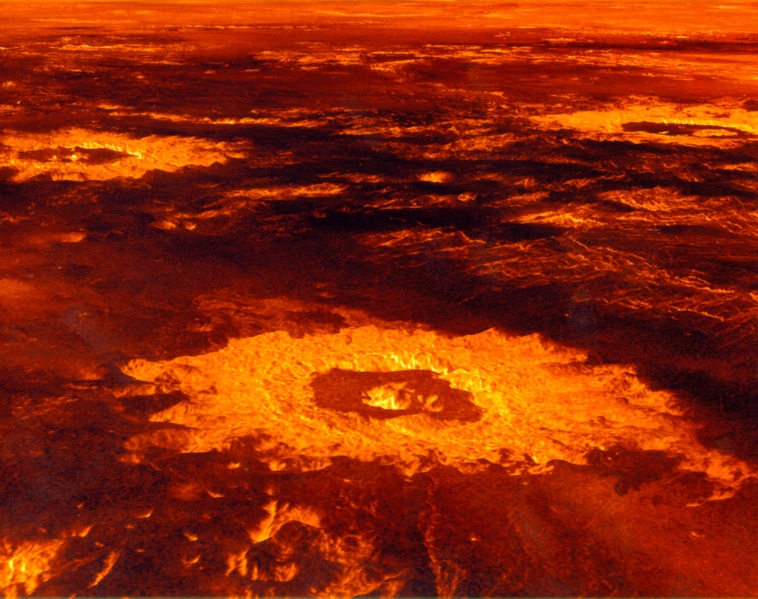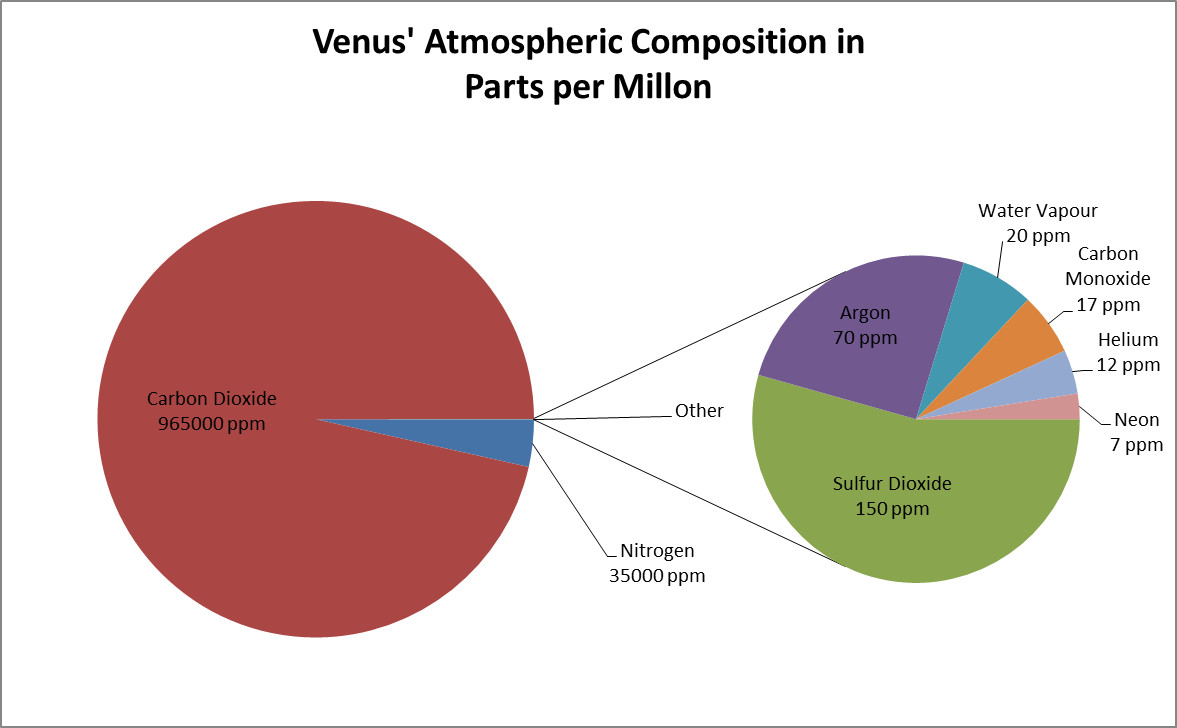 |
| The Magellan Spacecraft http://www.mediahex.com/Magellan_(spacecraft) |
The Magellan Spacecraft was used by NASA to collect radar images of the planet Venus, and it also collected altimetry and radiometry data to measure the surface topography and electrical characteristics of the planet. Magellan orbited Venus from 1990 to 1994 where at the end of its mission, it was commanded to plunge into the planet's dense atmosphere in order to gain data about the planets atmosphere and on its performance. The spacecraft then crash landed intentionally into the planet's surface, ending its mission. Thanks to the Magellan mission, we now know a lot more about many of the characteristics of the planet Venus.
 |
| Venus http://en.wikipedia.org/wiki/File:Venus_globe.jpg |
We have learned that Venus strangely rotates in the opposite direction as to all the other planets in the Solar System. In other words, it spins clockwise. There are many theories that suggest why Venus rotates in this direction. One theory that suggests why Venus does this, is that Venus may actually spin counterclockwise like all other planets, but it was simply flipped 180 degrees on its axis at some point. Scientist argue that the reason for Venus flipping like this may have been caused by that the sun's gravitational pull on the planet's very dense atmosphere, which could have caused strong atmospheric tides. These tides, combined with friction between Venus's mantle and core, could have caused the flip in the first place.
Another theory as to why Venus rotates this way rotates in such a way was suggested by Alexandre Corriera and Jacques Laskar. They suggest that Venus's rotation at one point slowed to a standstill, and then reversed direction. Taking into consideration the factors listed in the other theory, and the atmospheric tidal affects from other planets, the team concluded that Venus has shifted to a variety of positions through time. If it were flipped or not, it is bound to settle into one of four rotation states, two in either direction.
One other theory which could explain why Venus rotates differently is that Venus may have once been hit by a very large object, like an asteroid. The massive force of this impact could have caused Venus to spin in the opposite direction.
The Soviet Union also sent many unmanned landers to the surface of Venus. Many of these landers didn't make it to the planet, or once the arrived, they quickly were destroyed or they broke down due to the planet's intense heat and pressure. The most famous successful lander was Venera 13, which landed on Venus on March 1, 1982. The landing site of Venera 13 contained lava flows and small dome volcanoes, which indicated a very active surface. The landing site was described to be, "smooth but broken, and topped around the lander itself by abundant debris of various sizes." Temperatures on the surface were recorded to be extremely hot, and their was massive amounts of pressure. The lander was able to send color and black and white pictures of the surface of Venus and take other measurements for about two hours until it succumbed and broke down. Venera 13 may remain one of the best glimpses that humanity has been given of Venus's landscape.
 |
| A replica of the Soviet lander, Venera 13. This lander gave us one of the best glimpses of Venus's surface. http://en.wikipedia.org/wiki/Venera_13 |
 |
| Color pictures taken of the rugged Venusian landscape from the Venera 13 lander. http://apod.nasa.gov/apod/ap031130.html
Most of Venus's surface is covered by thick clouds, so we cannot get a very good view of it. But, missions to Venus have shown us what its surface looks like. The surface is covered in craters, volcanoes, mountains, and large lava plains. The temperatures on the surface are hot enough to melt lead at 464 degrees Celsius or 864 degrees Fahrenheit. The surface as I said before, is covered with clouds that are made of sulfuric acid which causes the planet to smell of a mixture of smoke and rotten eggs. Overall, the surface of Venus is a place that you would not want to be.
|
 |
| An impact crater left on the blazing surface of Venus. http://www.universetoday.com/14300/surface-of-venus/ |
Venus's atmosphere is made up almost completely of carbon dioxide. Very small amounts of nitrogen exist, as do the clouds of sulfuric acid, but the air of Venus is so dense that the small trace amounts of nitrogen are four times the amount of nitrogen on Earth, which makes up three-fourths of our atmosphere. Carbon monoxide, argon, sulfur dioxide, and water vapor make up about one percent of the atmosphere on Venus. The composition of the atmosphere causes a massive greenhouse gas effect to take place, which causes the planet to reach such extreme temperatures. This greenhouse effect causes Venus to not experience significant temperature changes throughout the year. The pressure experienced in Venus's atmosphere is also about 90 times greater as to what someone would experience on Earth. Even though Venus is considered to be the Earth's "sister planet," its surface and atmosphere that they have very few similarities.
 |
| This diagram shows the effect of Venus's extreme greenhouse effect compared to Earth's. http://www.castlerock.wednet.edu/HS/stello/Astronomy/TEXT/CHAISSON/BG306/HTML/BG30608.htm |
 |
| This pie chart shows the chemical composition of Venus's atmosphere. http://www.flickr.com/photos/lightbulb500/5894597393/ |
Magellan mapped Venus through the use of radar imagery and it also collected altimetry and radiometry data to measure the surface topography and electrical characteristics of the planet. Magellan discovered the massive amount of volcanic areas on Venus's surface such as vast lava planes, fields of small lava domes, large shield volcanoes, and large snaking rivers of lava that left deep trenches in the surface. Magellan also discovered that there are only a few impact craters on Venus, suggesting that the planet is geologically young, less than 800 million years old. Magellan also showed large pancake-shaped volcanic domes that suggest the presence of a type of lava produced by extensive evolution of crustal rocks.
Magellan also helped us figure out that there are active volcanoes on Venus. It has been shown through the evidence provided by the European Space Agency's Venus Express mission, which has been in orbit around the planet since April, 2006. The results from these missions were laid over the topographic data from Magellan's mission. Scientists saw compositional differences compared to the surrounding area in three volcanic regions. Relatively young lava flows have been identified by the way they emit infrared radiation. This suggests Venus is still capable of volcanic eruptions. Scientists also detected volcanic plumes, similar to volcanic hot spots on Earth like Hawaii, that produced significant eruptions. There is much more evidence that proves that volcanoes on Venus are still active, but just these pieces of evidence prove the still existent volcanic activity.
 |
| This scan of a volcano on Venus show the photographic evidence of volcanic activity. The bright zones indicate the more recently active regions of the volcano. http://solarsystem.nasa.gov/news/display.cfm?News_ID=33735 |
 |
| The Venusian volcano Maat Mons. This image was captured by the Magellan spacecraft. http://photography.nationalgeographic.com/photography/enlarge/venus-volcano_pod_image.html
Venus shows no evidence of plate tectonics. The evidence for this lack of evidence is that the planet lacks any signs of subduction zones, spreading ridges, and transform faults. There are some detectable evidence of plate tectonics in the planet's distant past, but apparently, at some point the process came to a standstill. What is believed though, is that due to the planet's extreme temperatures and pressure, the planet's crust is highly deformable, unlike the Earth's rigid crust. Venus's crust is easier to remodel than recycle. Volcanic hot spots are present on Venus, but they do not act as evidence of plate tectonics.
|
 |
| This diagram shows what scientist theorize what occurs underneath Venus's surface in comparison to the Earth's plates, http://web.ics.purdue.edu/~nowack/geos105/lect12-dir/lecture12.htm
Thank you for taking the time to read my blog post. I hope that you enjoyed and that it wasn't to lengthy.
-Tyler J
|

No comments:
Post a Comment
Note: Only a member of this blog may post a comment.